Public Service Enterprise Group Bundle
What's Next for Public Service Enterprise Group?
Public Service Enterprise Group (PSEG), a cornerstone of the energy sector since 1903, is undergoing a significant transformation. With a strategic pivot towards a regulated utility model, PSEG is reshaping its business to capitalize on the evolving energy landscape. This shift, coupled with substantial investments in infrastructure and clean energy, positions the company for sustained growth.
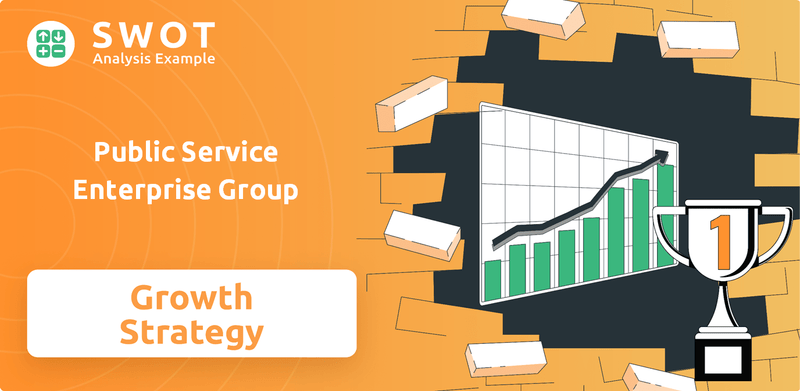
PSEG's strategic initiatives, including the sale of fossil fuel assets and focus on its core regulated business, highlight its commitment to long-term value creation. The company's Public Service Enterprise Group SWOT Analysis reveals key strengths and opportunities within the utility sector. Understanding PSEG's growth strategy and future prospects is crucial for investors and stakeholders navigating the dynamic energy market, as the company aims for a 5% to 7% non-GAAP Operating Earnings growth through 2029. This forward-looking approach emphasizes a commitment to operational excellence, customer satisfaction, and a sustainable energy future.
How Is Public Service Enterprise Group Expanding Its Reach?
The growth strategy of Public Service Enterprise Group (PSEG) is largely centered on significant capital investments in regulated assets. These investments are designed to modernize infrastructure, meet increasing energy demand, and support clean energy objectives within its service area. This approach is crucial for the company's business development and long-term sustainability in the utility sector.
PSEG's strategic initiatives are geared towards enhancing its infrastructure and service capabilities. These efforts are vital for maintaining a competitive edge and ensuring reliable energy delivery to its customers. The company's focus on strategic partnerships also plays a key role in its expansion into new markets.
Analyzing PSEG's financial performance review reveals a commitment to growth through strategic capital allocation. The company's expansion plans are not only about increasing capacity but also about adapting to the evolving energy landscape and meeting the demands of a cleaner energy future. For further insights, consider reading Owners & Shareholders of Public Service Enterprise Group.
PSEG has a substantial regulated capital investment plan, allocating between $21 billion and $24 billion for capital projects through 2029. This investment is expected to drive a compound annual growth in rate base of 6% to 7.5% for PSE&G from 2025 to 2029. The company’s rate base is projected to start from approximately $34 billion at the end of 2024.
The Clean Energy Future - Energy Efficiency II Program (CEF-EE II) is a significant initiative, with approximately $2.9 billion in approved spending. This program aims to help customers reduce energy usage, lower bills, and decrease carbon emissions. As of February 2025, nearly 415,000 customers have participated in PSE&G's CEF-EE programs.
PSEG is focused on infrastructure modernization projects, including reducing methane leaks, enhancing storm resiliency, and improving local reliability. These projects are critical for ensuring the reliability and safety of energy delivery. The company's commitment to these projects aligns with its sustainability goals and strategies.
There has been a notable increase in large load inquiries for new service connections. As of March 31, 2025, inquiries totaled over 6,400 MW of capacity requested, indicating potential future customer growth. This growth potential is a key factor in PSEG's long-term growth strategy.
PSEG's expansion initiatives are primarily driven by significant investments in infrastructure and clean energy projects. These investments are designed to meet the growing energy demands and support the transition to a cleaner energy future. The company's focus on these areas highlights its commitment to long-term growth and sustainability.
- Modernizing infrastructure to improve reliability and reduce environmental impact.
- Investing in clean energy programs to help customers reduce emissions and lower energy costs.
- Capitalizing on increasing demand for new service connections.
- Aligning with state policy goals for a cleaner energy future.
Public Service Enterprise Group SWOT Analysis
- Complete SWOT Breakdown
- Fully Customizable
- Editable in Excel & Word
- Professional Formatting
- Investor-Ready Format
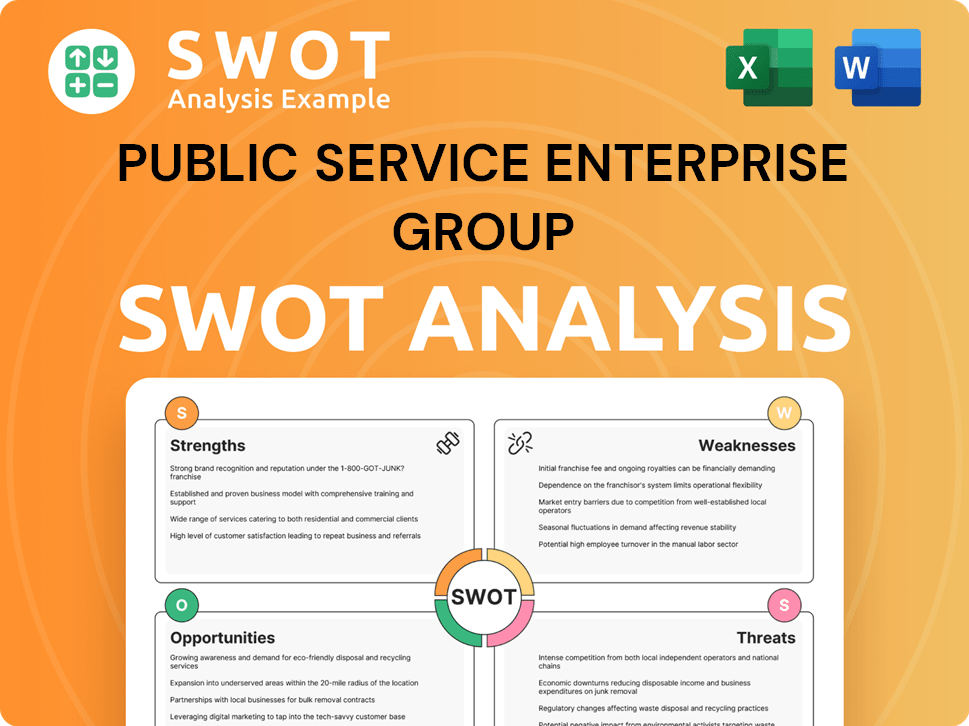
How Does Public Service Enterprise Group Invest in Innovation?
The company actively uses technology and innovation to fuel its growth, primarily focusing on significant investments in infrastructure modernization and advanced systems. This approach supports its long-term growth strategy within the utility sector. A key element of this strategy is the completion of its Advanced Metering Infrastructure (AMI) program, which demonstrates a commitment to operational excellence.
The focus on clean energy initiatives is another key aspect of its innovation strategy. The company's nuclear facilities are a major source of carbon-free power generation. Investments in energy efficiency programs are also a cornerstone, with the CEF-EE II program aiming to expand offerings and introduce new initiatives. These efforts are crucial for meeting evolving energy demands and achieving sustainability goals.
The continuous upgrades to its systems and adoption of new technologies highlight the company's dedication to meeting evolving energy demands. This commitment is further evidenced by its recognition as an ENERGY STAR Partner of the Year for Sustained Excellence in the Energy Efficiency Program Delivery category for the third consecutive year in February 2025.
The AMI program, with approximately 2.2 million smart meters installed, serves as a foundational technology. It enables more effective outage response and quicker power restoration, improving service reliability. This technology significantly enhances operational efficiency.
The company's nuclear facilities generate a substantial portion of carbon-free power. The company is actively exploring opportunities to grow its nuclear output, including potential long-term agreements. This supports its sustainability goals and strategies.
The CEF-EE II program expands offerings and introduces new initiatives like building decarbonization and demand response measures. These programs are vital for improving energy efficiency and reducing environmental impact. This is part of the company's overall business development strategy.
PSEG Long Island is focusing on electric vehicle (EV) make-ready programs and residential battery storage incentives. These initiatives support state clean energy goals and promote the adoption of sustainable energy solutions. These programs are part of the company's efforts to expand its business.
Continuous upgrades to systems and adoption of new technologies demonstrate a commitment to operational excellence. This approach ensures the company can meet evolving energy demands efficiently. These upgrades are essential for the company's future outlook.
The company was recognized with the ENERGY STAR Partner of the Year Award for Sustained Excellence in the Energy Efficiency Program Delivery category for the third consecutive year in February 2025. This recognition highlights its commitment to energy efficiency and sustainability.
The company's innovation strategy focuses on infrastructure modernization, clean energy, and energy efficiency programs. These initiatives are crucial for the company's future growth and market analysis. The company's commitment to these areas is evident in its strategic initiatives.
- AMI Program: Deployment of smart meters for improved outage response and power restoration.
- Clean Energy: Leveraging nuclear facilities and pursuing opportunities to increase output.
- Energy Efficiency: Expanding programs like CEF-EE II to include building decarbonization and demand response.
- EV and Battery Initiatives: Supporting electric vehicle infrastructure and residential battery storage.
For a deeper understanding of the company's financial structure, consider exploring the Revenue Streams & Business Model of Public Service Enterprise Group.
Public Service Enterprise Group PESTLE Analysis
- Covers All 6 PESTLE Categories
- No Research Needed – Save Hours of Work
- Built by Experts, Trusted by Consultants
- Instant Download, Ready to Use
- 100% Editable, Fully Customizable
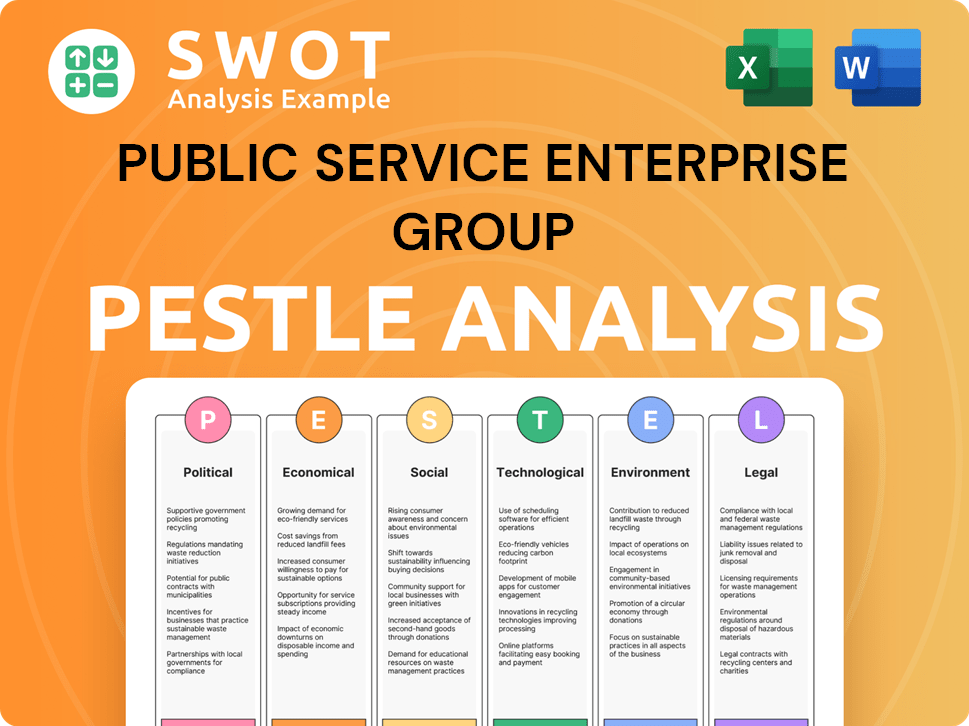
What Is Public Service Enterprise Group’s Growth Forecast?
The financial outlook for the company is promising, primarily due to its regulated business model and significant capital investments. The company's strategic focus on regulated activities is expected to drive substantial growth. This shift is reflected in the allocation of capital and the anticipated contribution to earnings.
In 2024, the company reported non-GAAP operating earnings of $3.68 per share. The company's guidance for 2025 anticipates non-GAAP operating earnings in the range of $3.94 to $4.06 per share. This represents an approximate 9% increase at the midpoint compared to the 2024 results, highlighting a positive trajectory for the utility sector.
The company's growth strategy is heavily reliant on its capital investment program. The total capital program is projected to be between $22.5 billion and $26 billion from 2025 to 2029, with over 90% of this allocated to regulated activities. This strong investment in infrastructure and modernization is a key element of its long-term growth strategy. For a deeper understanding of the competitive environment, consider exploring the Competitors Landscape of Public Service Enterprise Group.
The company achieved $3.68 per share in non-GAAP operating earnings in 2024, demonstrating solid financial health. This performance sets a strong foundation for future growth and strategic initiatives. The results reflect effective management and operational efficiency within the utility sector.
For 2025, the company projects non-GAAP operating earnings between $3.94 and $4.06 per share. This guidance indicates an approximate 9% increase at the midpoint, signaling continued progress. The forecast underscores confidence in the company's growth strategy and market position.
The company plans to invest between $22.5 billion and $26 billion from 2025 to 2029. Over 90% of this investment will be directed towards regulated activities, showing a strategic focus. This significant investment supports infrastructure upgrades and expansion.
The regulated capital investment program for PSE&G is projected to be $21 billion to $24 billion from 2025 to 2029. This investment is expected to support a rate base CAGR of 6% to 7.5% over the same period. The growth in rate base is a key driver of the company's financial outlook.
The company increased its indicative 2025 annual common dividend by 5% to $2.52 per share. This marks the 14th consecutive annual increase, reflecting financial stability. This increase demonstrates confidence in the company's future prospects.
As of March 31, 2025, the company reported approximately $4.6 billion of total available liquidity. This strong liquidity provides flexibility to execute its capital plan. The company is well-positioned to fund its growth initiatives.
Approximately 90% of the company's projected non-GAAP operating earnings over the 2025-2029 period are expected to come from PSE&G. This highlights the strategic shift towards regulated businesses. This shift is a key element of the company's growth strategy.
Public Service Enterprise Group Business Model Canvas
- Complete 9-Block Business Model Canvas
- Effortlessly Communicate Your Business Strategy
- Investor-Ready BMC Format
- 100% Editable and Customizable
- Clear and Structured Layout
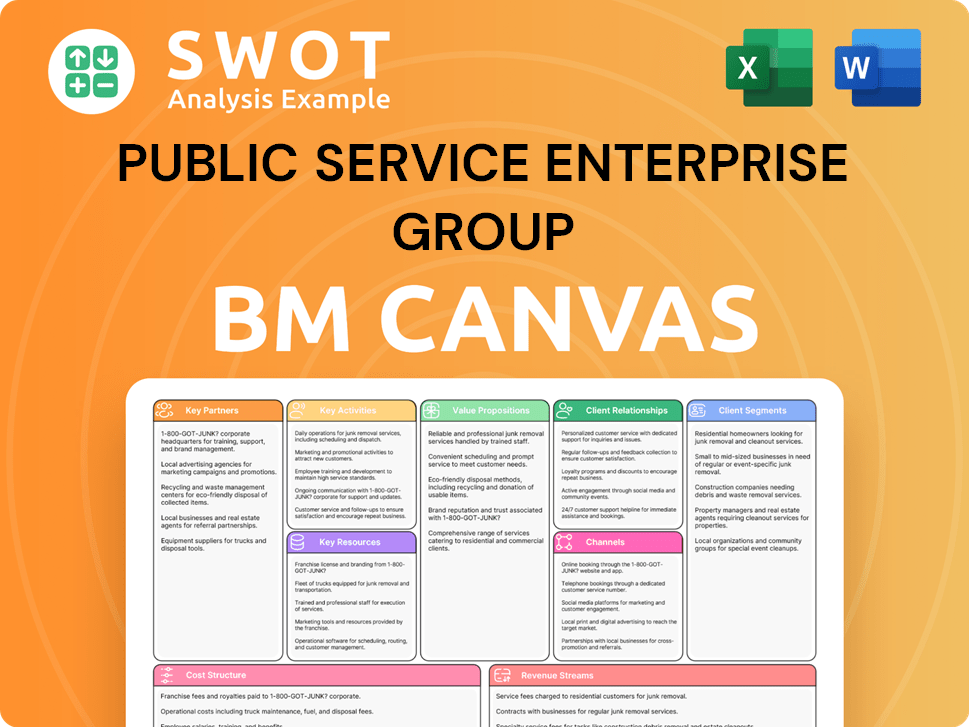
What Risks Could Slow Public Service Enterprise Group’s Growth?
The strategic and operational risks faced by Public Service Enterprise Group (PSEG) could affect its growth ambitions, even with its focus on regulated businesses. The company's ability to secure regulatory approvals for capital projects and recover costs through rates is crucial. Changes in regulations, particularly those related to climate change and energy efficiency, may impose additional costs or limit cost recovery, which could impact PSEG's business development.
Operational risks, including equipment failures, natural disasters, and cybersecurity attacks, pose significant challenges. Supply chain vulnerabilities, such as labor shortages and increased costs of equipment and materials, also present risks. PSEG also faces risks related to its nuclear facilities, including regulatory risks and nuclear fuel storage costs.
PSEG actively manages these risks through its strong balance sheet, supporting its five-year capital investment program, and by using mechanisms to stabilize rates. Environmental remediation costs at former manufactured gas plant (MGP) sites are estimated to be between $210 million and $234 million as of December 31, 2024.
Market competition and changes in the regulatory environment present challenges for PSEG. State and federal legislation, particularly those addressing climate change and energy efficiency, can introduce added costs or limit cost recovery, potentially affecting the company's financial performance.
Operational risks include equipment failures, natural disasters, and cybersecurity threats that could disrupt service and reliability. These events can lead to significant costs and operational challenges for PSEG, impacting its ability to meet customer demands and maintain its infrastructure.
Increased demand for power and load growth, potentially driven by a shift towards electrification, presents both opportunities and challenges for PSEG's grid infrastructure. This requires significant investment in upgrades and expansions to ensure reliable service.
Supply chain issues, including labor shortages and rising costs of equipment, materials, and fuel, can affect operations and financial results. These vulnerabilities can lead to project delays, increased expenses, and reduced profitability for PSEG.
PSEG faces risks associated with its nuclear facilities, including regulatory risks and the costs of nuclear fuel storage. These risks can impact the company's financial performance and require careful management and planning.
PSEG is addressing environmental conditions at former manufactured gas plant (MGP) sites, with remediation costs estimated between $210 million and $234 million as of December 31, 2024. Managing these environmental liabilities is crucial for the company's financial health and long-term sustainability.
Public Service Enterprise Group Porter's Five Forces Analysis
- Covers All 5 Competitive Forces in Detail
- Structured for Consultants, Students, and Founders
- 100% Editable in Microsoft Word & Excel
- Instant Digital Download – Use Immediately
- Compatible with Mac & PC – Fully Unlocked
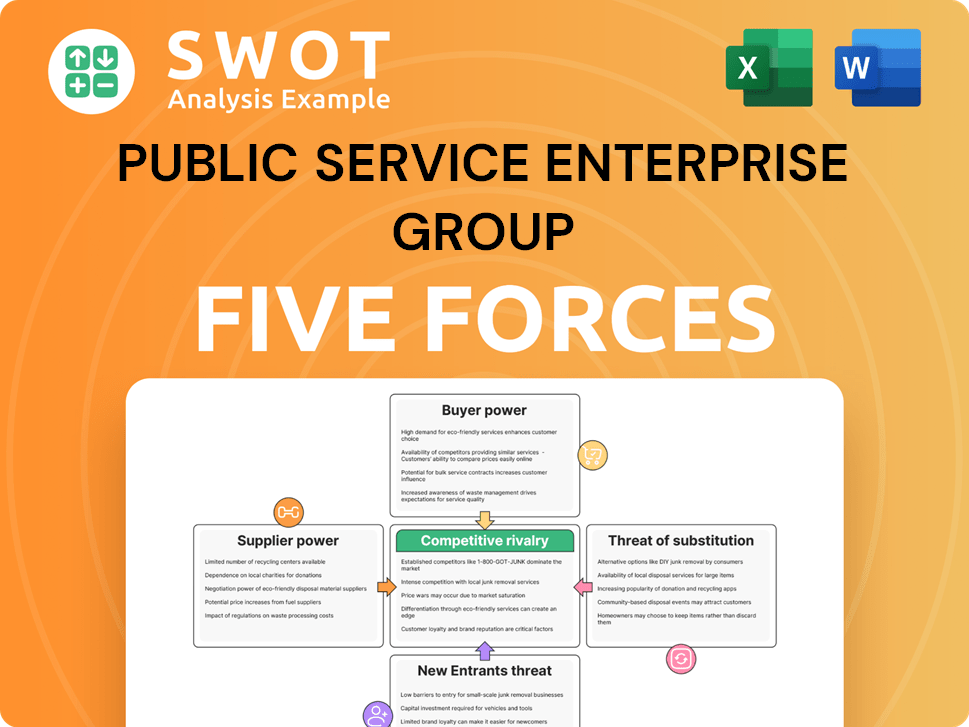
Related Blogs
- What are Mission Vision & Core Values of Public Service Enterprise Group Company?
- What is Competitive Landscape of Public Service Enterprise Group Company?
- How Does Public Service Enterprise Group Company Work?
- What is Sales and Marketing Strategy of Public Service Enterprise Group Company?
- What is Brief History of Public Service Enterprise Group Company?
- Who Owns Public Service Enterprise Group Company?
- What is Customer Demographics and Target Market of Public Service Enterprise Group Company?
Disclaimer
All information, articles, and product details provided on this website are for general informational and educational purposes only. We do not claim any ownership over, nor do we intend to infringe upon, any trademarks, copyrights, logos, brand names, or other intellectual property mentioned or depicted on this site. Such intellectual property remains the property of its respective owners, and any references here are made solely for identification or informational purposes, without implying any affiliation, endorsement, or partnership.
We make no representations or warranties, express or implied, regarding the accuracy, completeness, or suitability of any content or products presented. Nothing on this website should be construed as legal, tax, investment, financial, medical, or other professional advice. In addition, no part of this site—including articles or product references—constitutes a solicitation, recommendation, endorsement, advertisement, or offer to buy or sell any securities, franchises, or other financial instruments, particularly in jurisdictions where such activity would be unlawful.
All content is of a general nature and may not address the specific circumstances of any individual or entity. It is not a substitute for professional advice or services. Any actions you take based on the information provided here are strictly at your own risk. You accept full responsibility for any decisions or outcomes arising from your use of this website and agree to release us from any liability in connection with your use of, or reliance upon, the content or products found herein.